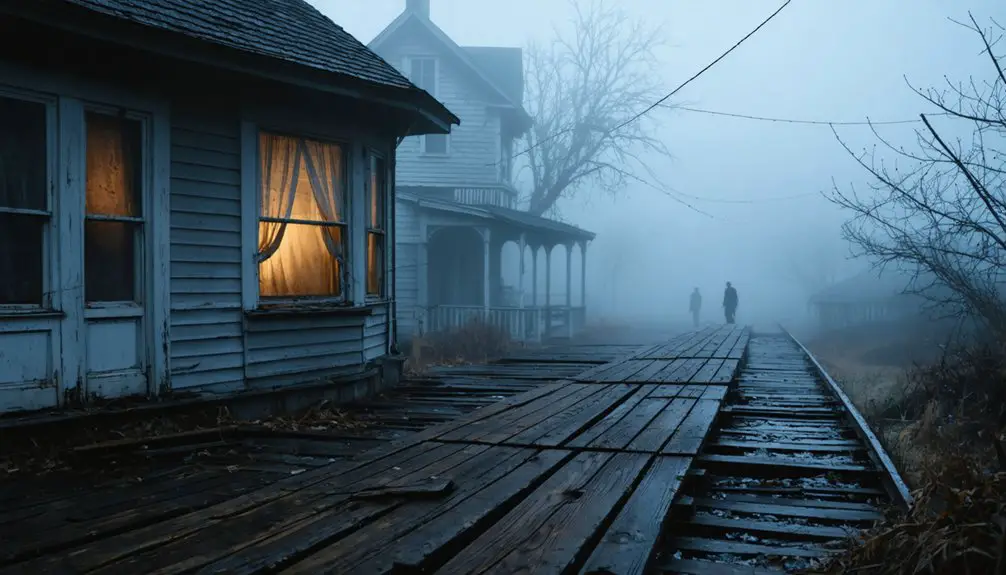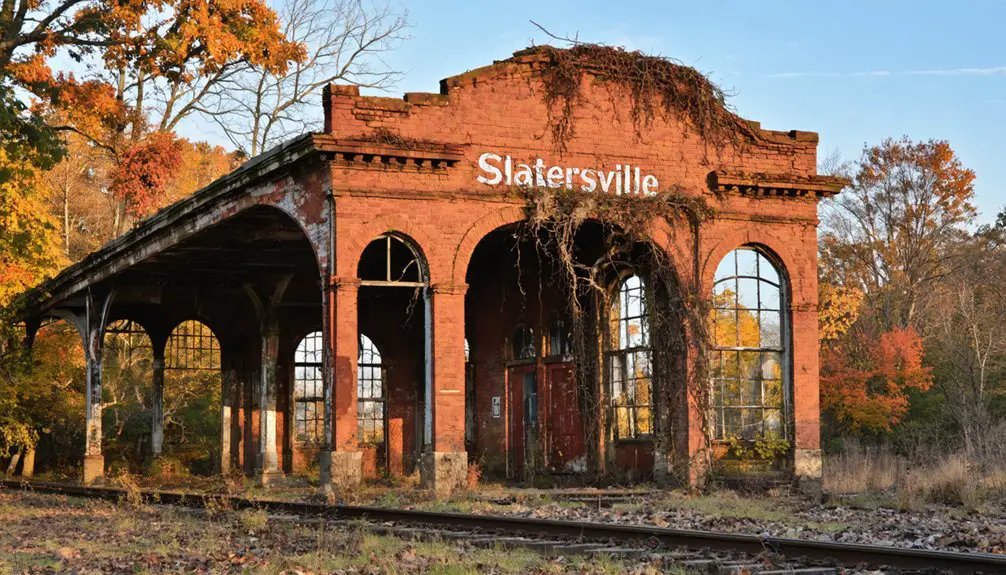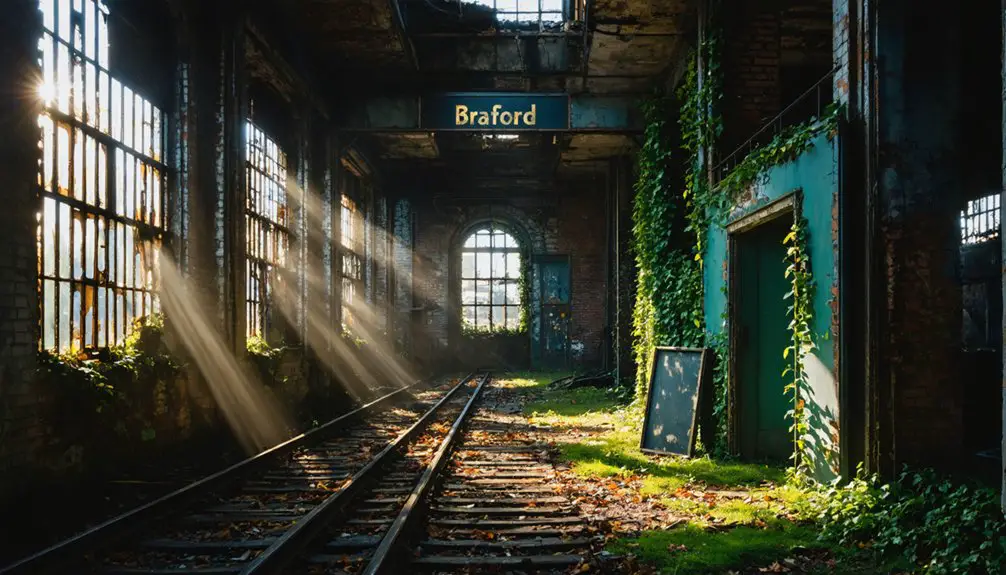You’ll find Slatersville Station as a poignant remnant of America’s first planned industrial village, established in 1803 by Samuel and John Slater. Once a vibrant two-story railroad depot serving Rhode Island’s textile empire, it now stands in quiet disrepair. While the station’s passenger service to Providence ended in the 1950s, it remains protected on the National Register of Historic Places. The site’s haunting atmosphere and reported paranormal activity hint at deeper historical mysteries waiting to be discovered.
Key Takeaways
- Slatersville Station, once a bustling two-story train depot, now stands abandoned and in disrepair since passenger service ended in the 1950s.
- The station is protected within the National Register of Historic Places as a historic remnant of Slatersville’s railroad era.
- Paranormal activity reports center around the nearby Polytop Corporation mill, including unexplained footsteps, voices, and shadow figures.
- The station’s decline mirrors Slatersville’s broader transformation from a thriving industrial center to a quieter residential community.
- Christian de Rezendes has documented compelling ghost stories and unexplained phenomena throughout the former mill village.
The Birth of America’s First Mill Village
Two enterprising brothers, Samuel and John Slater, laid the foundation for America’s first planned industrial village in 1803 when they acquired Buffum’s Mills along the Branch River.
With partners William Almy and Obadiah Brown, they transformed the small settlement, which had only a sawmill, gristmill, and blacksmith shop, into a revolutionary industrial center.
From humble rural mills emerged an industrial powerhouse, as visionary partners reshaped a simple settlement into manufacturing history.
You’ll find Slatersville’s architecture reflected careful planning unlike anything before it.
When the massive stone textile mill opened on July 4, 1807, it wasn’t just a standalone structure – it anchored an entire community.
The village’s innovative design included worker housing, a company store, and the owner’s residence, establishing new community dynamics.
John Slater maintained strong worker relations by staying directly involved with the community and addressing employee concerns.
The original mill structure burned down in 1826 by fire, leading to its replacement with a more durable stone building.
This thorough approach to industrial village planning set the standard that would shape America’s manufacturing landscape for generations to come.
Understanding Slatersville’s Ghost Town Status
While Slatersville’s industrial heritage remains prominently visible today, its once-bustling train station tells a different story.
You’ll find a haunting reminder of changing times in this ghost station, where trains now pass without passengers, and the once-vibrant two-story structure stands in disrepair.
The station’s decline mirrors broader shifts in American transportation. Like the abandoned ruins of Hanton City, this location reflects how changing infrastructure patterns led to the decline of once-thriving communities. As cars gained popularity in the 1950s and local industries waned, the passenger service that once connected Slatersville to Providence became obsolete.
By 1959, Amtrak shuttered the ticket office, though freight trains continued their passage. Designed by architect FW Miller, the station once hosted 70,000 monthly passengers during its peak operations in 1916.
While the station’s rail heritage is preserved within the National Register of Historic Places as part of the Slatersville Historic District, the building’s deteriorating state serves as a poignant symbol of America’s evolution from rail-dependent communities.
Historical Development and Industrial Legacy
When you explore Slatersville Station, you’ll encounter America’s first planned industrial village, established in 1807 by Samuel and John Slater who transformed Buffum’s Mills into a pioneering textile manufacturing center.
The Slaters constructed their granite mill complex along the Branch River, powered by the 170-acre Slatersville Reservoir, and surrounded it with worker housing, stores, churches, and civic buildings to create a self-contained community. The dressed-granite walls of the 1826 Center Mill remain a testament to the village’s durable construction. This historic site has been chronicled in the Slatersville Commemorative Guide as a significant part of Rhode Island’s heritage.
Your visit reveals how this site became the prototype for the Rhode Island System of manufacturing, which integrated industrial production with worker community life and was replicated throughout the Blackstone Valley during the 19th century.
Mill Village Origins
After extensive scouting of potential mill sites in the region, John Slater established Slatersville in July 1807 as America’s first planned industrial village.
You’ll find that he strategically chose Buffum’s Mills, which already had a sawmill, gristmill, and blacksmith shop in place. The site’s mill village architecture developed around a massive stone mill rather than a traditional village green, breaking from conventional New England town planning.
Water power from the 170-acre Slatersville reservoir drove the mill’s operations, with Slater securing essential water rights along the Branch River. Samuel and John Slater’s venture into this location proved transformative, as their child labor workforce became integral to the mill’s early success.
The original 1807 stone mill, though later destroyed by fire in 1826, represented the second cotton mill on the Blackstone River and marked the beginning of independent Slater family industrial control in the region.
Industrial Transformation Timeline
Throughout its early industrial expansion from 1807 to 1843, Slatersville underwent remarkable growth starting with the original four-story stone mill that launched the Slaters’ independent manufacturing empire.
After fire destroyed the first mill in 1826, they built the larger Center Mill, followed by the Granite Mill in 1843 – key industrial milestones that shaped the village’s destiny.
You’ll find major economic shifts marked by infrastructure developments, including the strategic Woonsocket and Pascoag Railroad connection and an expanded power canal system.
By 1900, the Slater family sold to James R. Hooper, who redirected operations toward bleaching and dyeing.
When Henry P. Kendall acquired the property in 1915, he modernized while preserving the village’s character.
Notable Landmarks and Structures
As America’s first planned mill village, Slatersville features several remarkable landmarks that showcase its industrial heritage, with the Slatersville Mill Complex at its heart.
Like other settlements that experienced decline during the Industrial Revolution, many residents relocated as manufacturing shifted away from these historic villages.
You’ll find Greek Revival mill architecture throughout the historic district, where the Branch River once powered the bustling textile operations.
While exploring the village, you’ll discover well-preserved worker housing along Main, Green, Church, and School Streets, reflecting the community cohesion that defined early industrial life.
The abandoned Slatersville train station stands as a reflection of the village’s railroad era, when the Woonsocket and Pascoag line connected local mills to broader markets. Like the historic Pawtucket station, it remains a testament to Rhode Island’s once-thriving railway network.
Notable institutional buildings, including the North Smithfield Public Library and 19th-century churches, complete the historic landscape, offering glimpses into daily life during America’s industrial revolution.
Local Folklore and Paranormal Claims

While Slatersville’s historical significance is well-documented, its paranormal reputation stems largely from nearby Hanton City, dubbed the “Haunted City” in an 1880s Providence Journal article.
The folklore evolution surrounding these locations blends factual history with speculative tales, though documented ghostly encounters remain sparse. Christian de Rezendes shared compelling stories of unexplained noises during the mill’s abandonment period.
The folklore evolution surrounding these locations blends factual history with speculative tales, though documented ghostly encounters remain sparse.
You’ll find most paranormal claims centered around the Polytop Corporation mill, where owners reported unexplained footsteps and voices in the 1990s.
- Shadow figures and mysterious voices reported at Slater Mill
- Local stories of unexplained disappearances from Hanton City
- Theories ranging from plague outbreaks to alien abductions
- Eerie ruins, cellar holes, and stone walls fueling supernatural speculation
- North Smithfield Heritage Association’s ongoing efforts to document authentic ghost stories
Economic Evolution Through the Ages
You’ll find Slatersville’s economic story began with John Slater’s ambitious 1806 textile mill, which established one of America’s first planned industrial villages with company-owned housing and water-powered manufacturing.
The village’s fortunes rose through the 19th century as the textile industry flourished, with expansions including the Western Mill in 1821 and Mill #3 in 1843 creating a self-contained industrial community.
You can trace the area’s economic decline to the mid-20th century when changing textile markets forced mill closures, transforming this once-bustling industrial center into a quieter residential community.
Mill-Driven Industrial Growth
The economic evolution of Slatersville Station began in 1807 when John Slater strategically established his industrial complex along the Branch River, transforming a modest collection of sawmills and gristmills into America’s second major cotton manufacturing center.
You’ll find its growth was powered by a 170-acre reservoir that drove the machines, while an industrial workforce of local families operated the cotton spinning systems.
- First planned industrial village in America, creating the “Rhode Island System” blueprint
- Pioneer of water-powered textile manufacturing using Arkwright’s system
- Site of America’s first factory strike in 1824, led by women workers
- Catalyst for regional economic transformation from farming to industry
- Self-contained mill village with worker housing, stores, and civic buildings
Post-Manufacturing Economic Shifts
Following the closure of Slatersville’s textile operations in the 1950s, this once-thriving industrial hub underwent dramatic economic transformation.
You’ll find that aging infrastructure, cheaper competition, and shifting consumer demands forced local industries to adapt or perish.
The community’s resilience emerged through creative economic adaptation. Former mill buildings now serve as residential spaces, while small business incubators and artisan workshops breathe new life into historic structures.
You’ll notice how the workforce has shifted from manufacturing to service sectors, with many residents commuting to metropolitan areas for employment.
Tourism now plays an essential role, as heritage sites and museums showcase Slatersville’s industrial legacy.
Through preservation grants and development initiatives, the town continues to balance its rich history with modern economic needs.
Modern Business Landscape Today
Since shifting away from its manufacturing roots, Slatersville’s modern business landscape has evolved into a diverse economic ecosystem.
You’ll find entrepreneurial trends spanning advanced manufacturing, tech startups, and service industries reshaping the local economy. Digital innovation has enabled remote workers and freelancers to thrive in renovated historic spaces, while expanded broadband infrastructure supports new business ventures.
The area’s heritage buildings now host mixed-use developments combining retail, offices, and light industrial operations.
- Advanced manufacturing and technology firms replacing traditional mill operations
- Growing healthcare, education, and professional service sectors
- Emergence of remote work hubs and co-working spaces in historic buildings
- Small-scale artisanal businesses capitalizing on local heritage
- Green technology and renewable energy projects gaining momentum
Preservation Efforts and Heritage Protection
As America’s first planned mill village, Slatersville benefits from robust preservation efforts led by the North Smithfield Historical Association and Rhode Island Historic Preservation Commission.
Through heritage advocacy, these organizations work to protect the village’s authentic structures while maneuvering preservation challenges of aging infrastructure and modern development pressures.
Heritage advocates fight to preserve Slatersville’s historic buildings while navigating infrastructure decay and development demands.
You’ll find numerous initiatives underway to safeguard Slatersville’s legacy, including filmmaker Christian de Rezendes’ thorough PBS documentary and ongoing collection of oral histories.
Federal and state historic registers provide legal protection for key buildings, while grant programs offer financial support for restoration projects.
The careful balance of structural preservation with public access guarantees you can still experience the village’s historic character through guided tours, educational programs, and interpretive displays that bring Slatersville’s industrial past to life.
Tourism Potential and Visitor Experience
When you visit Slatersville’s historic district, you’ll discover a well-designed mile-long walking tour that connects seven key historical sites through the village’s atmospheric streets.
The heritage storytelling comes alive through interpretive signs and National Park Service materials that detail America’s first planned industrial village. You’ll feel transported back to the 19th century as you explore the original mill buildings, church, and worker housing that define this preserved landscape.
- Self-guided tours with detailed maps from Blackstone River Valley National Historical Park
- Stunning photography opportunities of the stone mill and town common
- Authentic New England industrial architecture with minimal modern intrusion
- Visitor engagement through seasonal community events and programs
- Immersive historical experience highlighting mill worker life and industrial innovation
Comparing Slatersville to Other New England Ghost Towns
While Slatersville stands as America’s first planned mill village with preserved historic structures, it differs markedly from New England’s more desolate ghost towns like Hanton City and the Ramtail Factory.
You’ll find Slatersville’s well-maintained mills and community layout still functioning, unlike the scattered ruins and cellar holes that characterize its abandoned counterparts.
The ghost town characteristics between these sites couldn’t be more distinct.
Where Hanton City has crumbled into foundation remnants and overgrown stone walls, and the Ramtail Factory exists only as fire-damaged ruins deep in the woods, Slatersville’s buildings remain intact and accessible.
Even the paranormal reputation sets them apart – Slatersville lacks the haunting legends that made the Ramtail Factory notorious and contributed to other ghost towns’ mystique.
The Future of Slatersville’s Historical Identity
You’ll find Slatersville’s historical identity thriving through its successful mill-to-residential conversion project and inclusion in the broader Blackstone River Valley heritage initiatives.
While the 150-acre historic district preserves the architectural legacy of America’s first planned industrial village, you can witness how modern zoning ordinances and preservation efforts carefully balance development with cultural authenticity.
The proposed Local Historic District designation and potential National Park status will shape how you’ll experience this vibrant New England community, where historic preservation meets contemporary living needs.
Heritage Tourism Development Potential
As America’s first planned mill village shifts into the 21st century, Slatersville’s heritage tourism potential stands poised for significant development.
You’ll find this historic Rhode Island gem ready for transformation through strategic investments in preservation and visitor experiences. Community engagement initiatives are creating opportunities for local entrepreneurs while protecting the authentic character that makes this mill village unique.
- State and federal grants available for heritage preservation projects
- Interactive experiences including reenactments and digital interpretation tools
- Development of museums and interpretive centers to showcase mill village history
- Enhanced visitor amenities and accessibility improvements
- Local cultural festivals and heritage events celebrating mill village traditions
The economic impact of heritage tourism here promises sustainable growth through increased visitor spending, job creation, and cultural preservation efforts that’ll maintain Slatersville’s historical significance for future generations.
Preserving Mill Village Identity
Since its establishment as America’s first planned mill village, Slatersville’s historical identity has remained deeply rooted in its pioneering industrial architecture and thoughtfully designed community layout.
You’ll find heritage continuity preserved through the 1826 and 1843 granite mills, now adaptively reused as apartments while maintaining their historic character.
The original water-powered infrastructure, including mill trenches and power canals, stands as a symbol of early American industrial innovation.
Community resilience shines through the preserved network of worker housing, company store, church, and town hall – all exemplifying the Rhode Island System of manufacturing communities.
The village’s authentic character benefits from protective frameworks within the Blackstone River Valley National Historical Park, ensuring future generations can experience this unique slice of industrial heritage.
Modern Community Cultural Evolution
While preserving its historic legacy, Slatersville’s transformation into a modern residential community showcases the successful fusion of past and present.
Through thoughtful cultural integration, you’ll find a vibrant mix of historic preservation and contemporary living that’s reshaping this former mill village. Community engagement flourishes in shared spaces designed for today’s lifestyle needs, from collaborative workspaces to social gathering areas.
- Designer lofts feature original exposed brick and beams alongside modern amenities
- Resident programs and social events cultivate neighborhood connections
- Mixed-use spaces accommodate diverse household types and lifestyles
- Riverside walking trails and outdoor facilities promote active living
- Full-service management provides urban conveniences while maintaining historic charm
This evolution represents a sustainable approach to urban growth while honoring Slatersville’s rich industrial heritage, creating an authentic living experience that bridges centuries.
Frequently Asked Questions
What Happened to the Original Slater Family Members Who Lived in Slatersville?
You’ll find John Slater managed operations until his death in 1843, while his sons John F. and William took control until 1900, when these Slater descendants sold their family legacy to James Hooper.
Are There Any Underground Tunnels Beneath the Old Mill Buildings?
Dark as midnight rumors swirl, but you won’t find any confirmed tunnels beneath Slatersville’s mills. Despite enthusiastic tunnel exploration attempts, historical records and structural evidence don’t support underground passages’ existence.
What Was the Peak Population of Slatersville During Its Industrial Height?
You’ll find the peak population exceeded 1,000 residents during industrialization in the 1890s, when mill employment reached 700 workers. The village experienced significant population decline after 1900.
Did Any Major Fires or Disasters Occur in Early Slatersville?
You’ll find two major fire incidents struck Slatersville’s early mills – the first textile mill burned in 1826, leading to stone reconstruction, while the lower mill’s 1842 fire prompted rebuilding and expansion in 1843.
Where Did Most Mill Workers Originally Come From to Work Here?
Like early Uber drivers, you’d find local farming families were first recruited, not Irish immigrants yet. Kids and parents worked together under Samuel Slater’s supervision, enduring tough labor conditions in the mills.
References
- https://www.nrinow.news/2023/02/02/ghost-stories-wanted-n-s-heritage-association-looks-to-document-towns-paranormal-activity/
- https://newenglandhistoricalsociety.com/six-new-england-ghost-towns/
- https://www.geotab.com/ghost-towns/
- http://freepages.rootsweb.com/~gtusa/history/usa/ri.htm
- https://www.youtube.com/watch?v=IU2v9qEpRpo
- https://en.wikipedia.org/wiki/Slatersville
- https://blackstoneheritagecorridor.org/wp-content/uploads/2020/06/Slatersville-Walking-Tour2020.pdf
- https://environmentamericas.org/2024/08/22/life-in-a-mill-village/
- https://www.rimonthly.com/learn-the-history-of-slatersville-in-this-new-pbs-series/
- https://www.youtube.com/watch?v=mnlAArcGj1A



